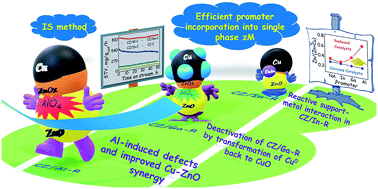Group 13 metal doped Cu/ZnO catalysts from phase pure precursors via an isomorphous substitution route: mechanistic insights into promotional effects for syngas hydrogenation to methanol†
Abstract
In the mixture of coprecipitated precursors of Cu/ZnO/Al2O3 catalysts, only the fraction of Al3+ ions incorporated into a single-phase zinc malachite actually contributes to the dilution of Cu2+ and is responsible for the promotional action. However, the preparation of promoter ion doped phase pure zinc malachite is difficult via coprecipitation routes and further, the effect of such promotion on the microstructure properties and activity is poorly understood. The present isomorphous substitution method delivers a controlled and efficient incorporation of group 13 metal ions, viz., Al3+, Ga3+ and In3+ into the pure phase malachite structure. The formation of M3+-doped pure phase precursors ensured maximum dilution of Cu2+ ions that lead to a compelling improvement in the microstructure properties of the calcined catalysts. As compared to the undoped catalyst, the Al3+ and Ga3+-doped catalysts exhibited an ∼8 and ∼5.4-fold increase in the methanol formation rate, respectively. The best performing Al3+-doped catalyst exhibited superior microstructure properties and high (855 mg gcat−1 h−1) and stable STYMeOH, which could be correlated with the promoter induced O vacancy sites. As a consequence of the promotion, the Cu–ZnO synergy was found to be improved resulting in the formation of a reduced ZnOx overlayer as evidenced by XPS-AES and N2O coupled H2 TPD analyses. The Ga3d XPS and 27Al MAS NMR results suggested that in the reduced catalysts, the major fractions of Al3+ and Ga3+ were found to be incorporated into the tetrahedral sites of the ZnO lattice and led to the contraction of unit cell volume eventually resulting in the modification of electronic properties of ZnO by inducing defects in its structure. Surprisingly, In3+ exhibited a detrimental effect on the catalytic performance as a result of its revoked dilution effect in the reduced catalyst owing to its reactive support–metal interaction resulting in the formation of a Cu–In bimetallic alloy.



 Please wait while we load your content...
Please wait while we load your content...